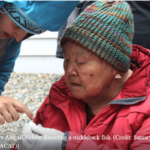Community-Based Participatory Resarch on Saint Lawrence Island – How Yupik Residents are Helping to Identify Persistent Pollutants in Their Communities
December 13, 2017 @ 9:00am (AKST)
 The Yupik People of Saint Lawrence Island, Alaska report high rates of cancer, thyroid disease, diabetes, heart disease, and birth defects. One cause of these negative health outcomes may be toxic exposure to persistent organic pollutants. St. Lawrence Island residents face combined exposures to contaminants at abandoned military installations from the Cold War era and from atmospheric deposition into the Arctic.
The Yupik People of Saint Lawrence Island, Alaska report high rates of cancer, thyroid disease, diabetes, heart disease, and birth defects. One cause of these negative health outcomes may be toxic exposure to persistent organic pollutants. St. Lawrence Island residents face combined exposures to contaminants at abandoned military installations from the Cold War era and from atmospheric deposition into the Arctic.
The Yupik People have 6-10 times higher PCBs in the blood of their people than the average American in the lower 48. Persistent chemicals bio-accumulate up the food web and concentrate in the body fats of walruses, seals, and whales. As a result, the marine mammals that are a mainstay of the traditional diet contain high levels of pollutants such as PCBs though these chemicals were banned globally decades ago.
A National Institute of Environmental Health Sciences (NIEHS) funded community-based participatory research project on the Island is working to document levels of PCBs, flame retardant chemicals, perfluorinated compounds, and chlorinated pesticides through sampling of freshwater fish, household dust and blood serum of residents. Listen to this podcast to hear how this collaborative research is helping to identify what contaminants are present and to find solutions to reduce exposures.
Cold War-era military site continues to pollute fish and Yupik people (Environmental Health News, December 4, 2017)
Featured speakers
Frank von Hippel, Professor in the Department of Biological Sciences, Northern Arizona University
Vi Waghiyi, Tribal Member, Native Village of Savoonga and Environmental Health and Justice Program Director, Alaska Community Action on Toxics
